2014 FIAT 500L LIVING START STOP
[x] Cancel search: START STOPPage 90 of 420
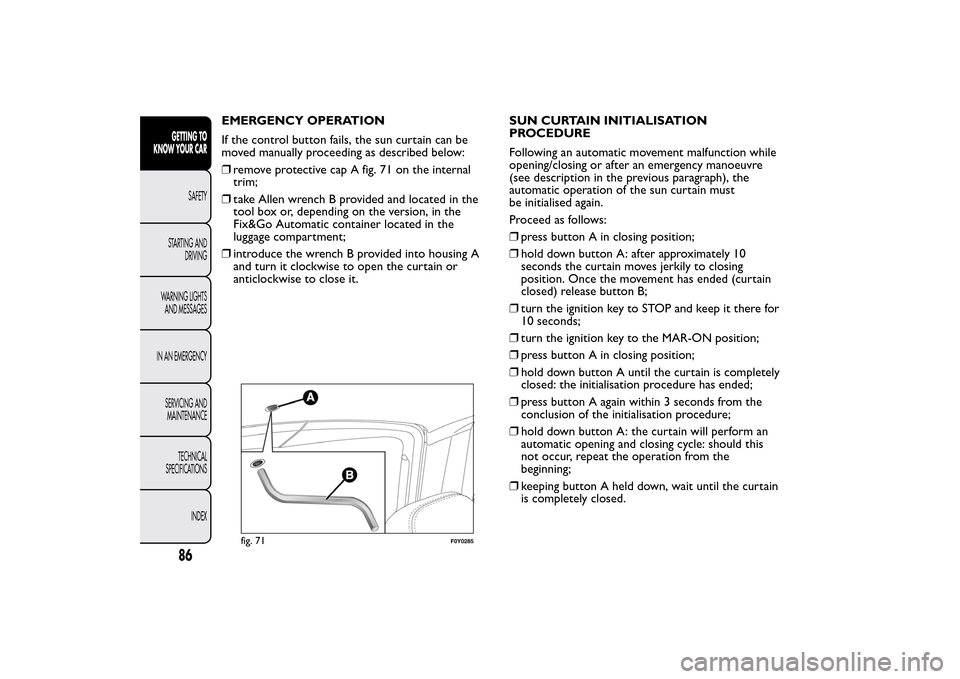
EMERGENCY OPERATION
If the control button fails, the sun curtain can be
moved manually proceeding as described below:
❒remove protective cap A fig. 71 on the internal
trim;
❒take Allen wrench B provided and located in the
tool box or, depending on the version, in the
Fix&Go Automatic container located in the
luggage compartment;
❒introduce the wrench B provided into housing A
and turn it clockwise to open the curtain or
anticlockwise to close it.SUN CURTAIN INITIALISATION
PROCEDURE
Following an automatic movement malfunction while
opening/closing or after an emergency manoeuvre
(see description in the previous paragraph), the
automatic operation of the sun curtain must
be initialised again.
Proceed as follows:
❒press button A in closing position;
❒hold down button A: after approximately 10
seconds the curtain moves jerkily to closing
position. Once the movement has ended (curtain
closed) release button B;
❒turn the ignition key to STOP and keep it there for
10 seconds;
❒turn the ignition key to the MAR-ON position;
❒press button A in closing position;
❒hold down button A until the curtain is completely
closed: the initialisation procedure has ended;
❒press button A again within 3 seconds from the
conclusion of the initialisation procedure;
❒hold down button A: the curtain will perform an
automatic opening and closing cycle: should this
not occur, repeat the operation from the
beginning;
❒keeping button A held down, wait until the curtain
is completely closed.
fig. 71
F0Y0285
86GETTING TO
KNOW YOUR CAR
SAFETY
STARTING AND
DRIVING
WARNING LIGHTS
AND MESSAGES
IN AN EMERGENCY
SERVICING AND
MAINTENANCE
TECHNICAL
SPECIFICATIONS
INDEX
Page 93 of 420

INITIALISATION PROCEDURE
Following an automatic movement malfunction while
opening/closing or after an emergency manoeuvre
(see description in the previous paragraph), the
automatic operation of the sun roof must be
initialised again.
Proceed as follows:
❒press button A fig. 72 in closing position;
❒turn the ignition key to STOP and keep it there for
10 seconds;
❒turn the ignition key to the MAR-ON position;
❒hold down button A: after approximately 10
seconds the roof moves jerkily to closing position.
When the movement stops (closed roof ), release
button A (if the roof is already closed, you will
hear the mechanical lock only);
❒press button A again within 3 seconds from the
conclusion of the initialisation procedure;
❒hold down button A: the roof will perform an
automatic opening and closing cycle. Should this
not occur, repeat the operation from the
beginning;
❒keeping button A held down, wait until the roof is
completely closed;
❒the initialisation procedure is over.
DOORSDOOR CENTRAL LOCKING/UNLOCKING
Locking the doors from outside
With doors closed, press the
button on the
remote control or turn the metal insert (located
inside the key) in the driver side door lock.
The LED above the
fig. 74 button switches on to
indicate that the doors have been locked.
Door locking is carried out with all doors shut,
irrespective of the luggage compartment open/closed
status.
fig. 74
F0Y0039
89GETTING TO
KNOW YOUR CARSAFETY
STARTING AND
DRIVING
WARNING LIGHTS
AND MESSAGES
IN AN EMERGENCY
SERVICING AND
MAINTENANCE
TECHNICAL
SPECIFICATIONS
INDEX
Page 97 of 420
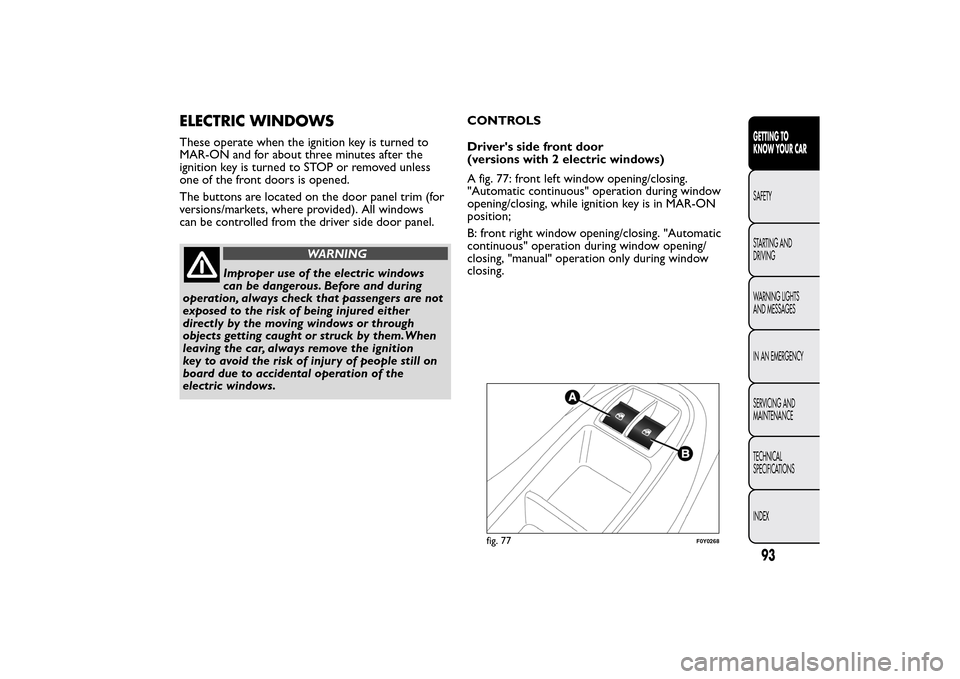
ELECTRIC WINDOWSThese operate when the ignition key is turned to
MAR-ON and for about three minutes after the
ignition key is turned to STOP or removed unless
one of the front doors is opened.
The buttons are located on the door panel trim (for
versions/markets, where provided). All windows
can be controlled from the driver side door panel.
WARNING
Improper use of the electric windows
can be dangerous. Before and during
operation, always check that passengers are not
exposed to the risk of being injured either
directly by the moving windows or through
objects getting caught or struck by them.When
leaving the car, always remove the ignition
key to avoid the risk of injury of people still on
board due to accidental operation of the
electric windows.CONTROLS
Driver's side front door
(versions with 2 electric windows)
A fig. 77: front left window opening/closing.
"Automatic continuous" operation during window
opening/closing, while ignition key is in MAR-ON
position;
B: front right window opening/closing. "Automatic
continuous" operation during window opening/
closing, "manual" operation only during window
closing.
fig. 77
F0Y0268
93GETTING TO
KNOW YOUR CARSAFETY
STARTING AND
DRIVING
WARNING LIGHTS
AND MESSAGES
IN AN EMERGENCY
SERVICING AND
MAINTENANCE
TECHNICAL
SPECIFICATIONS
INDEX
Page 98 of 420

Driver's side front door
(versions with 4 electric windows)
A fig. 78: front left window opening/closing.
"Continuous automatic" operation during window
opening/closing stage and anti-pinch system activated.
B: front right window opening/closing. "Continuous
automatic" operation during window opening/closing
stage and anti-pinch system activated.
C: enabling/disabling of rear door electric window
controls
D: rear left window opening/closing (for versions/
markets, where provided). "Continuous automatic"
operation during window opening/closing stage
and anti-pinch system activated:
E: rear right window opening/closing (for versions/
markets, where provided). "Continuous automatic"
operation during window opening/closing stage
and anti-pinch system activated.Use the buttons to open/close the desired window.
Window opening
Push the buttons to open the desired window.
When one of the two buttons is pressed briefly, the
window moves in "stages"; if the button is held
down, "continuous automatic" operation is activated.
If the button is pressed again, the window will stop
in the desired position.
Window closing
Lift the buttons to close the desired window.
The window closing stage occurs following the same
logics described for the opening stage.
Front and rear passenger doors
(for versions/markets, where provided)
On the passenger side front door panel trim, and on
some versions also on the rear doors, buttons are
provided to control the associated windows.
fig. 78
F0Y0240
94GETTING TO
KNOW YOUR CAR
SAFETY
STARTING AND
DRIVING
WARNING LIGHTS
AND MESSAGES
IN AN EMERGENCY
SERVICING AND
MAINTENANCE
TECHNICAL
SPECIFICATIONS
INDEX
Page 99 of 420
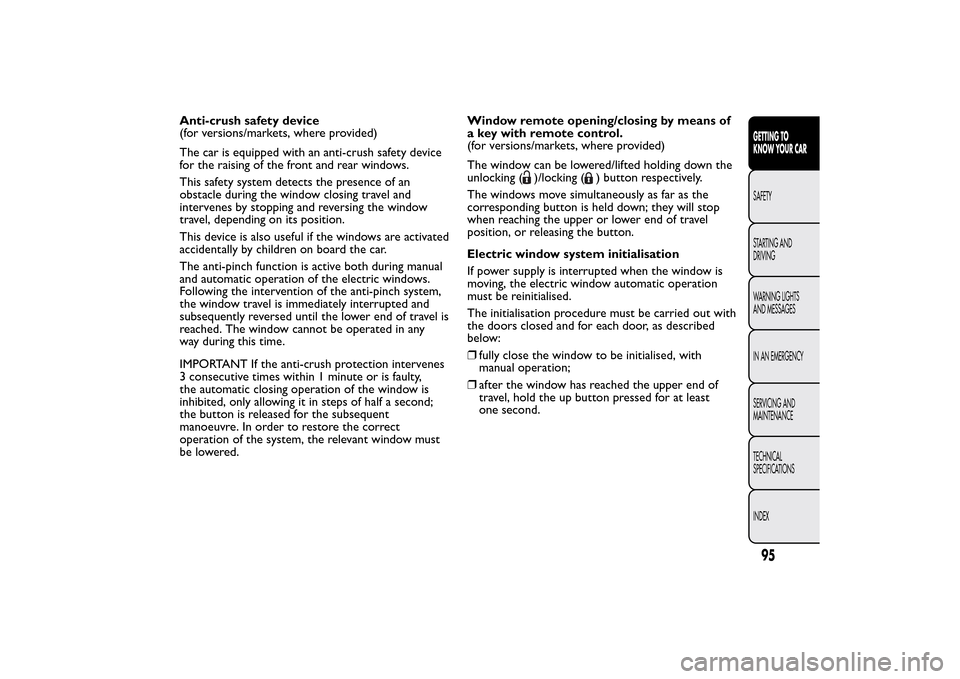
Anti-crush safety device
(for versions/markets, where provided)
The car is equipped with an anti-crush safety device
for the raising of the front and rear windows.
This safety system detects the presence of an
obstacle during the window closing travel and
intervenes by stopping and reversing the window
travel, depending on its position.
This device is also useful if the windows are activated
accidentally by children on board the car.
The anti-pinch function is active both during manual
and automatic operation of the electric windows.
Following the intervention of the anti-pinch system,
the window travel is immediately interrupted and
subsequently reversed until the lower end of travel is
reached. The window cannot be operated in any
way during this time.
IMPORTANT If the anti-crush protection intervenes
3 consecutive times within 1 minute or is faulty,
the automatic closing operation of the window is
inhibited, only allowing it in steps of half a second;
the button is released for the subsequent
manoeuvre. In order to restore the correct
operation of the system, the relevant window must
be lowered.Window remote opening/closing by means of
a key with remote control.
(for versions/markets, where provided)
The window can be lowered/lifted holding down the
unlocking (
)/locking (
) button respectively.
The windows move simultaneously as far as the
corresponding button is held down; they will stop
when reaching the upper or lower end of travel
position, or releasing the button.
Electric window system initialisation
If power supply is interrupted when the window is
moving, the electric window automatic operation
must be reinitialised.
The initialisation procedure must be carried out with
the doors closed and for each door, as described
below:
❒fully close the window to be initialised, with
manual operation;
❒after the window has reached the upper end of
travel, hold the up button pressed for at least
one second.
95GETTING TO
KNOW YOUR CARSAFETY
STARTING AND
DRIVING
WARNING LIGHTS
AND MESSAGES
IN AN EMERGENCY
SERVICING AND
MAINTENANCE
TECHNICAL
SPECIFICATIONS
INDEX
Page 111 of 420
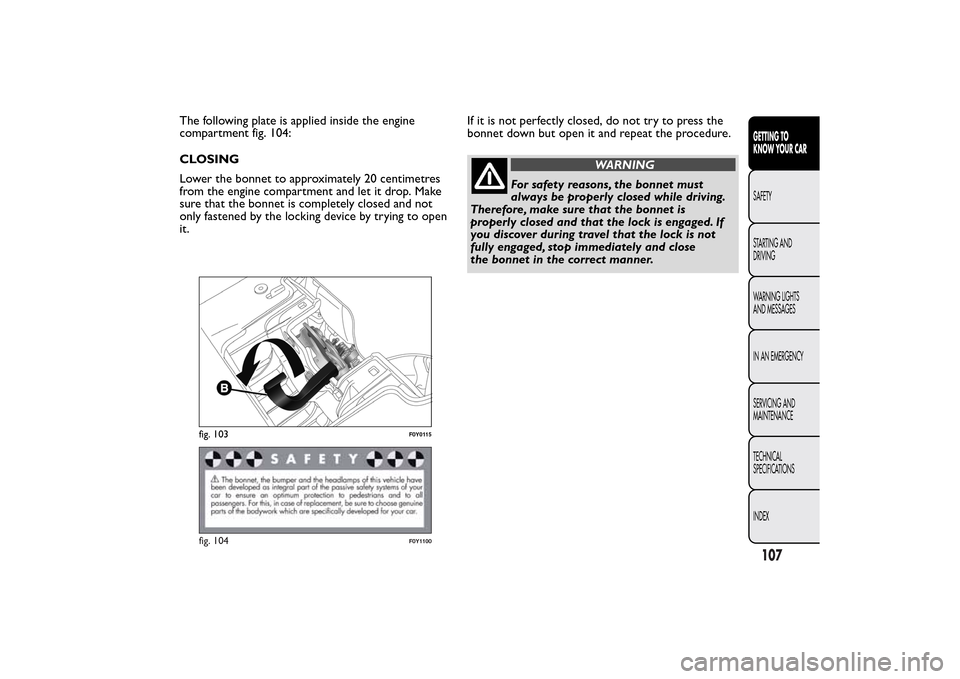
The following plate is applied inside the engine
compartment fig. 104:
CLOSING
Lower the bonnet to approximately 20 centimetres
from the engine compartment and let it drop. Make
sure that the bonnet is completely closed and not
only fastened by the locking device by trying to open
it.If it is not perfectly closed, do not try to press the
bonnet down but open it and repeat the procedure.
WARNING
For safety reasons, the bonnet must
always be properly closed while driving.
Therefore, make sure that the bonnet is
properly closed and that the lock is engaged. If
you discover during travel that the lock is not
fully engaged, stop immediately and close
the bonnet in the correct manner.
fig. 103
F0Y0115
fig. 104
F0Y1100
107GETTING TO
KNOW YOUR CARSAFETY
STARTING AND
DRIVING
WARNING LIGHTS
AND MESSAGES
IN AN EMERGENCY
SERVICING AND
MAINTENANCE
TECHNICAL
SPECIFICATIONS
INDEX
Page 115 of 420
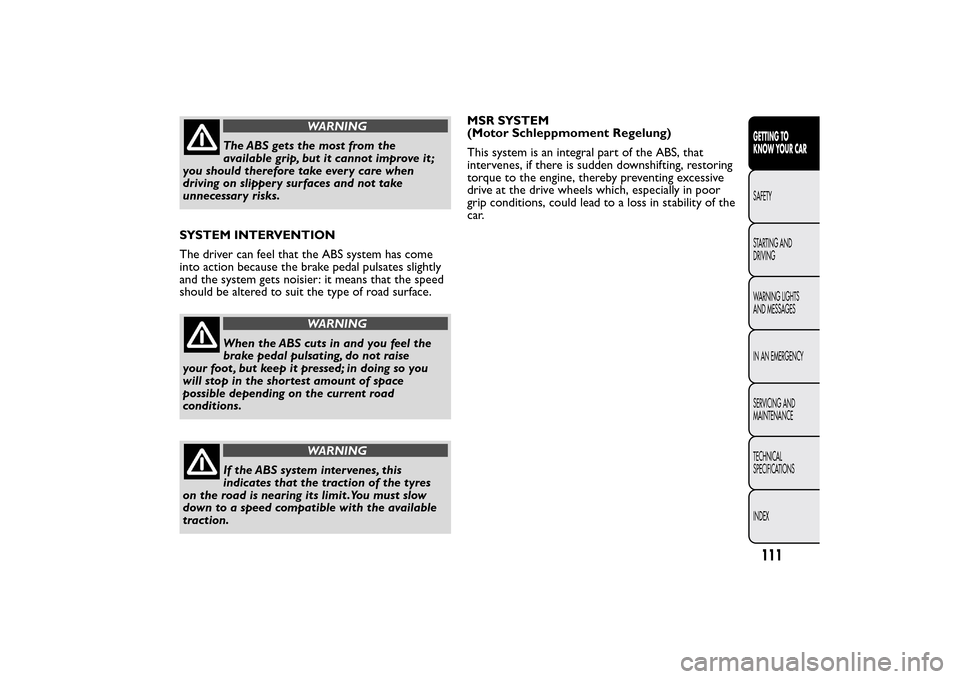
WARNING
The ABS gets the most from the
available grip, but it cannot improve it ;
you should therefore take every care when
driving on slippery surfaces and not take
unnecessary risks.
SYSTEM INTERVENTION
The driver can feel that the ABS system has come
into action because the brake pedal pulsates slightly
and the system gets noisier: it means that the speed
should be altered to suit the type of road surface.
WARNING
When the ABS cuts in and you feel the
brake pedal pulsating, do not raise
your foot , but keep it pressed; in doing so you
will stop in the shortest amount of space
possible depending on the current road
conditions.
WARNING
If the ABS system intervenes, this
indicates that the traction of the tyres
on the road is nearing its limit .You must slow
down to a speed compatible with the available
traction.MSR SYSTEM
(Motor Schleppmoment Regelung)
This system is an integral part of the ABS, that
intervenes, if there is sudden downshifting, restoring
torque to the engine, thereby preventing excessive
drive at the drive wheels which, especially in poor
grip conditions, could lead to a loss in stability of the
car.
111GETTING TO
KNOW YOUR CARSAFETY
STARTING AND
DRIVING
WARNING LIGHTS
AND MESSAGES
IN AN EMERGENCY
SERVICING AND
MAINTENANCE
TECHNICAL
SPECIFICATIONS
INDEX
Page 118 of 420
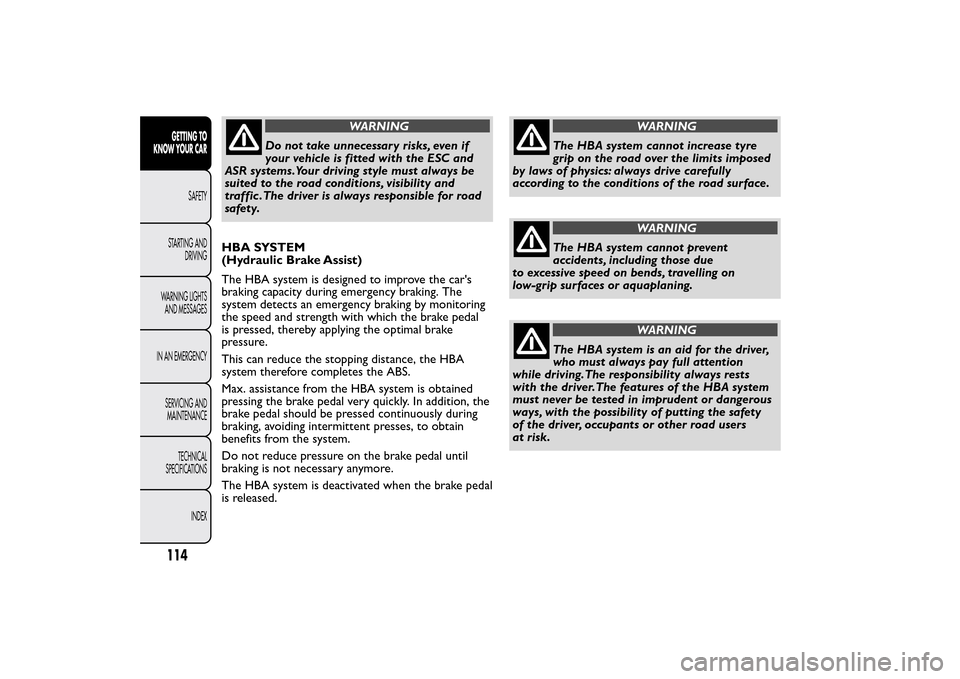
WARNING
Do not take unnecessary risks, even if
your vehicle is fitted with the ESC and
ASR systems.Your driving style must always be
suited to the road conditions, visibility and
traffic .The driver is always responsible for road
safety.
HBA SYSTEM
(Hydraulic Brake Assist)
The HBA system is designed to improve the car's
braking capacity during emergency braking. The
system detects an emergency braking by monitoring
the speed and strength with which the brake pedal
is pressed, thereby applying the optimal brake
pressure.
This can reduce the stopping distance, the HBA
system therefore completes the ABS.
Max. assistance from the HBA system is obtained
pressing the brake pedal very quickly. In addition, the
brake pedal should be pressed continuously during
braking, avoiding intermittent presses, to obtain
benefits from the system.
Do not reduce pressure on the brake pedal until
braking is not necessary anymore.
The HBA system is deactivated when the brake pedal
is released.
WARNING
The HBA system cannot increase tyre
grip on the road over the limits imposed
by laws of physics: always drive carefully
according to the conditions of the road surface.
WARNING
The HBA system cannot prevent
accidents, including those due
to excessive speed on bends, travelling on
low-grip surfaces or aquaplaning.
WARNING
The HBA system is an aid for the driver,
who must always pay full attention
while driving.The responsibility always rests
with the driver.The features of the HBA system
must never be tested in imprudent or dangerous
ways, with the possibility of putting the safety
of the driver, occupants or other road users
at risk.
114GETTING TO
KNOW YOUR CAR
SAFETY
STARTING AND
DRIVING
WARNING LIGHTS
AND MESSAGES
IN AN EMERGENCY
SERVICING AND
MAINTENANCE
TECHNICAL
SPECIFICATIONS
INDEX